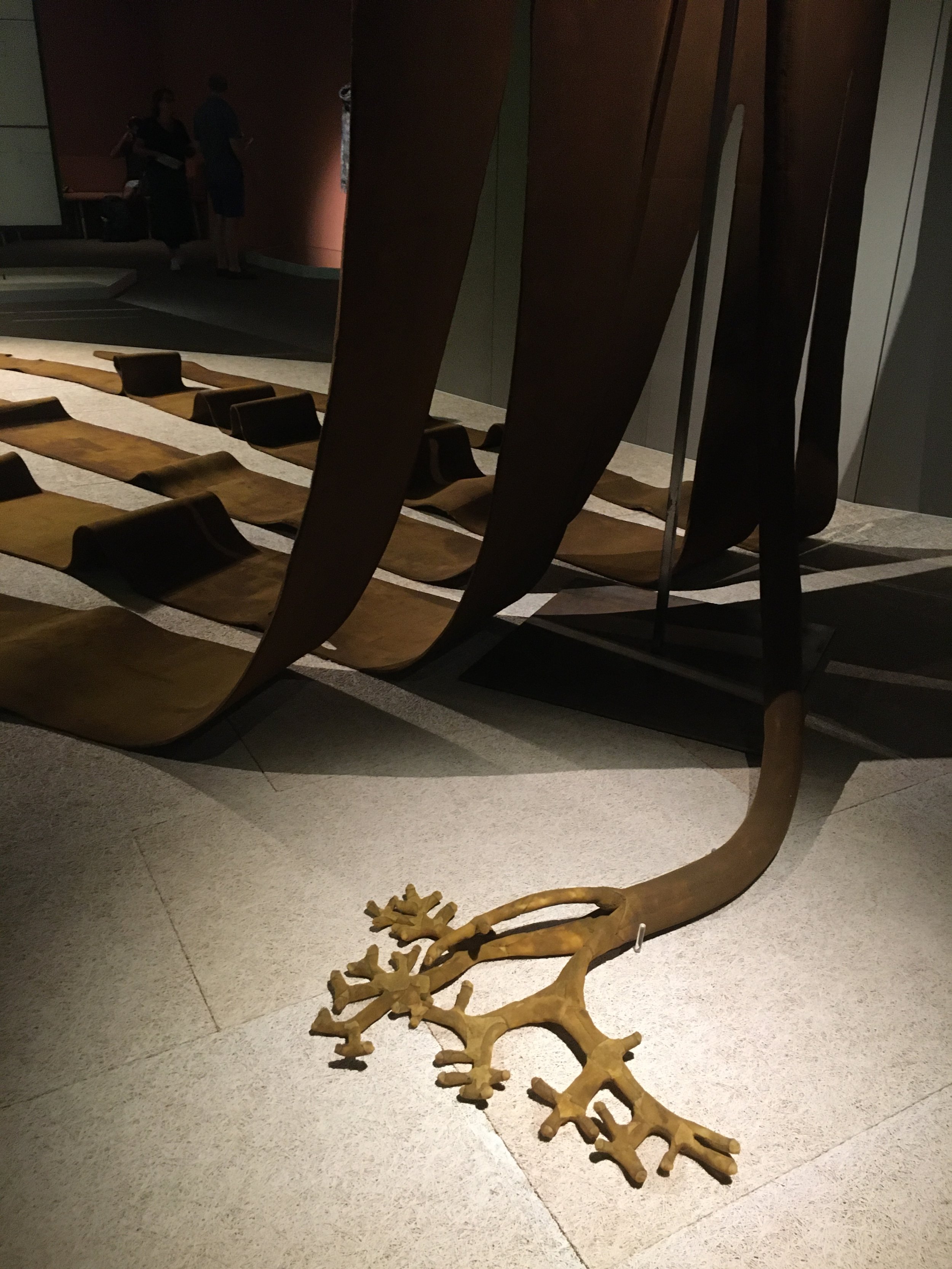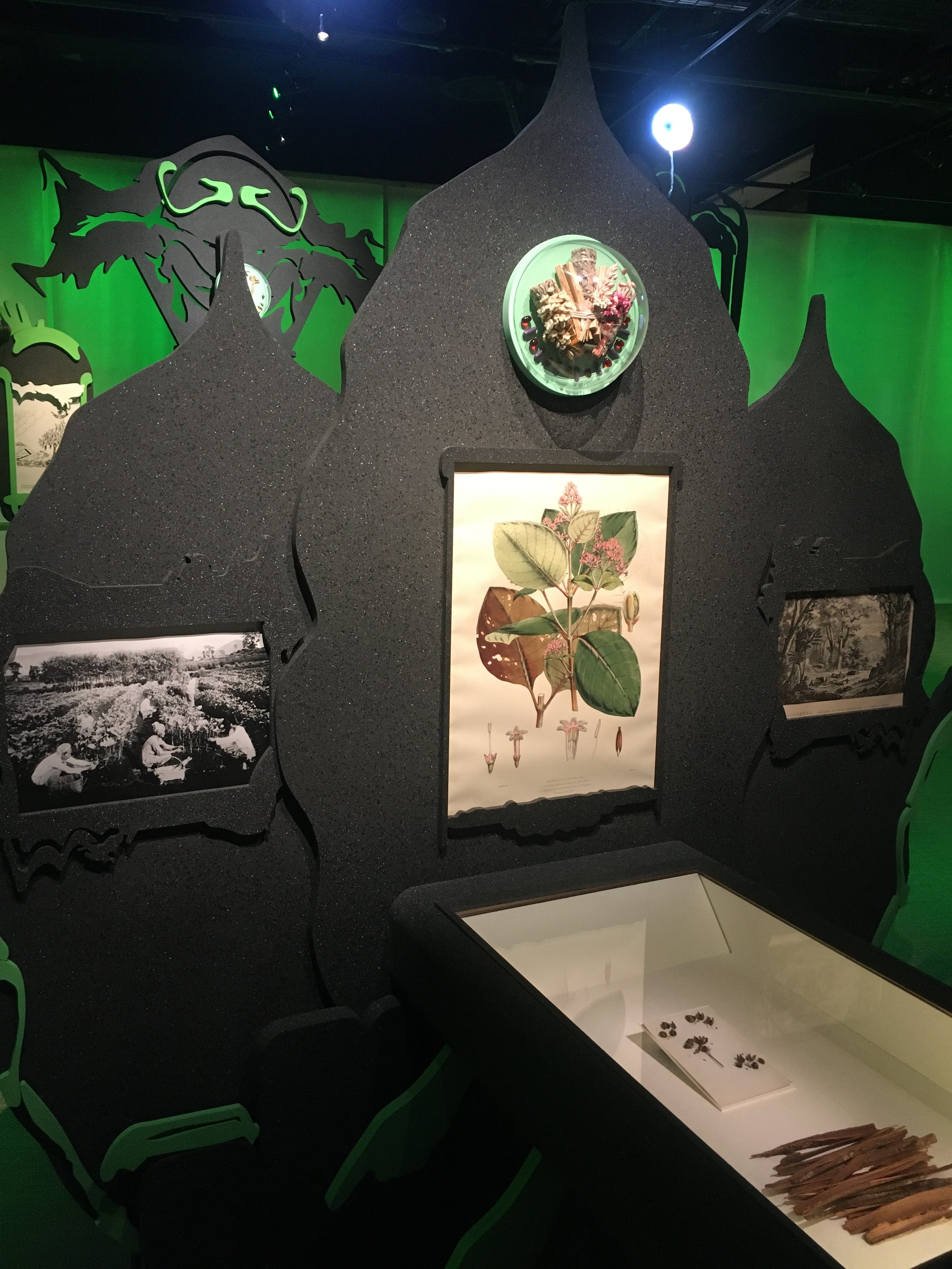Rooted Beings.
Rooted Beings was an exhibition at Wellcome Collection in 2022 that aimed to honour the significance and agency of the ancient, complex and sensitive beings that co-exist in a symbiotic relationship, from plants to fungi to humans, and how we might reimagine our relationship with them all.
“Today, humans represent only 0.01 per cent of the world’s biomass, but our way of life has led to the extinction of many species. The exploitation of plants was amplified to a global scale during the scientific expeditions to Latin America in he 18th century, when European colonial administrations collected hundreds of botanical specimens. Indigenous knowledge was appropriated and codified in manuscripts. Plants were separated from the cultural and ecological ecosystems they belonged to.” ~ Rooted Beings exhibition guide.
This exhibition was less scientific than I had anticipated with it being housed at Wellcome Collection, a free museum in London exploring health and human experience. But the textile-heavy artworks add to the tactility we experience in the natural world, and the sections of ‘symbiosis’, ‘colonial violence and indigenous knowledge’, and ‘wildness’ all entangled with one another as threads, and vines, and climates, and stories do.
Read on for some highlights, along with excerpts from the fantastic exhibition guide.
“Our vegetal companions emerged from the water and colonised the land 450 million years ago. Only 300,000 years ago Homo spaiens evolved and 13,000 years ago humans began cultivating plants through agriculture in a reciprocal process of domestication. In turn, agriculture rooted human culture, as farming replaced the nomadic hunter-gatherer existence.”
The exhibition was introduced by a series of textile hangings from Gözde Ilkin that showed humans and plants writhing about together. Apart from the beautiful hand-stitching of the appliqué, the imagery itself is mysterious and intriguing with all entities merging together. Stitched by Ilkin and her mother, these textile artworks are a collage of linens, tablecloths and curtains with natural dyes and embroidery as a blending of ancestral materials and technical knowledge.
Images: Gözde Ilkin, ‘As the Roots Spoke, the Cracks Deepen’; 1. ‘The Ground Opening: Mourning and Birth’, and 2. ‘The Entrustment Shaman’ and ‘Bridges’.
Some artefacts from the Wellcome Collection’s collection were on show throughout, grounding the spirtual artworks into scientific notions. The Ecological Relation of Roots by John Ernst Weaver, 1919 is a hand-drawn diagram of root structures after a soil trench was cut, highlighting the depth and entanglement at which roots go to find nutrition. What isn’t shown here of course is mycorrhizal fungi as this is only just coming to light as a thing. The book, written 10 years later, highlights individually the root structures of certain plants, and actually nicely shows the difference between layers i.e. canopy (trees) and herbaceous.
Images: John Ernst Weaver, ‘The Ecological Relation of Roots’, 1919 and ‘Plant Ecology’ book, 1929.
Biopiracy and large-scale extractivism,
the new forms of colonialism that silence numinous
knowledge and subjugate peoples.
Ancestral authorities are imprisoned, even murdered,
for defending their territories.
Their communities are displaced.
Indigenous peoples reclaim their right to the ritual
use of sacred plants.
Ritual and medicinal uses of plants are also forms of resistance.
~ Angélica Muñoz, Perspective Activity
Presented in dialogue with the futuristic installation by Patricia Domínguez (covered below), there were drawings by Joseca, a member of the Yanomami community in the Brazilian Amazon who are constantly struggling to defend their lives, rights and home from deforestation, mining and infectious diseases. Joseca’s detailed drawings illustrate the significance of trees as central to the ecosystem that supports us all.
Images: 1. Drawing from Yanomami community member Joseca; 2. Photo of Yanomami processing tubers [credit: Edson Sato].
Our association with plant matter (materials) came up throughout. Giant installations of foam seaweed were placed at the museum entrance and in the exhibition, along with a camouflage-esque suit, and a leafy den.
Eduardo Navarro’s Index of Shapes prototype skin suit, 2021 uses a fabric that mirrors the bark of the London plane tree [Platanus x acerifolia], made by Soft Tissue Studio and due to be used in a performance piece under a London plane in a square local to the museum. London plane trees have been readily chopped down in this area outside Euston to make way for HS2.
Ingrid Ihrman’s giant seaweed installations - as part of a wider project, The Inner Ocean - reflect upon the fluid that surrounds egg cells of all land-living mammals, a liquid that shares the same salinity as our primal ocean had. The installations suggest a deep connection between the ocean and land through our own bodies, as the flora of the sea and the flora of our gut. I appreciated the stuffed silk materials of the foyer work, Gut Weed [Ulva intestinalis], but the painted foam of Laminaria digitata didn’t work for me despite it being a good easy-access material for a large work; I have a piece of this seaweed (preserved) after working with it for an art commission, and it doesn’t feel spongey.
Sop’s Portable Den, The Den 3 audio, and accompanying information board with written script and audio description (2021) provide insight into how natural materials and outdoor spaces can breed familiarity, or be made to be protective. The den was created by gathering leaves, illustrating them, and fixing them to a net, with this slow making picked up as and when capacity allowed (over period of pandemic lockdown). It is an example of how crafting and making offers up a connection, not only to the physical materials, but to our ancestral roots.
Images: 1. Eduardo Navarro, ‘Index of Shapes prototype skin suit’, 2021; 2. Ingrid Ihrman, ‘A Great Seaweed Day [Laminaria digitata]’, 2019; 3. Ingrid Ihrman, ‘A Great Seaweed Day [Ulva intestinalis]’, 2019; 4. Sop, ‘Portable Den’, 2021; 5. Sop, ‘Den 3’ script and audio description, 2021.
Throughout the Anthropocene, in our role as super predators, we have widley overtaxed the generosity of plants, and our way of life has led to the extinction of many species. After all they have given us, the time has come for humanity to nurture them. Reciprocity with the vegetal world is the only path for us to take to become truly ‘rooted beings’.
~ Cristina Nieto, The Conquest of Terra Firma
Vegetal Matrix.
Patricia Domínguez’s experimental research on ethnobotany, healing practies and the commercialisation of wellbeing is brought together in this exhibit-within-an-exhibit. Vegetal Matrix uses the South American and European collections at the Royal Botanic Gardens, Kew and Wellcome Collection to explore narratives of colonial and neo-colonial violence. It focuses on a selection of specimens, and draws together archival imagery and video, plant material, botanical drawings and contemporary-made totems.
I found it particularly interesting to see the plant materials, having very rarely come across any of the selected specimens in raw form. The totems were interesting on their own, but I guess I didn’t quite make the connection between them and the specimen (they all looked relatively similar). The archival materials drew it all together so that it was art-science combined, and the exhibition guide provided more on the research, which I’ll included below.
Mandrake [Mandagora sp.] ⇾ a member of the Solanaceae family, mandrake have sedative and aeaesthetic properties and were used by women healers to increase fertility and ease childbirth - practices deemed witchcraft by the church. Due to the similarity of mandrake’s roots to the human body, the plant was arbitrarily gendered according to the binary terms that dominate natural history - however, many plants are hermaphrodites with both ‘male’ and ‘female’ parts.
Ayahuasca/yagé ⇾ a hallucinogenic brew used by indigenous and mestizo cultures in South America for millennia to connect with a spiritual plane of existence, to cure illnesses or to communicate with nature. It has been increasingly commodified by Western cultures, which has cut it off from indigenous holistic views of the world. ‘Ayahuasca’ is the Quechua name for a concoction of Banisteriopsis caapi, Morton vines and leaves from the Psychotria viridis. Many ayahuasca spiritual retreats are owned by outsiders leading to a 300% rise in the last decade in the cost of ayahuasca for locals.
Brugmansia [Brugmansia sp.] ⇾ this and the closely-related Datura species [Solanaceae] bear trumptes of scented hallucinogenic flowers that have been used for healing across the centuries - and criminal activity. Rich in scopolamine, hyoscyamine and several other tropane alkaloids, all parts of Brugmansia plants are potentially poisonous and can lead to delirium. For this reason, scopolamine is extracted from Brugmansia to erase willpower from victims of kidnapping, sexual assault and robberies. Many species are now considered extinct in the wild due to overharvesting and habitat destruction.
Cinchona [Cinchona sp.] ⇾ it is unclear how this genus was discovered as a remedy for malaria, but the orange bark of the large evergreen trees in this genus native to South America is the source of bitter anti-malarial quinine alkaloids. It protected the labourers and soldiers of the empires in colonised territories against disease, and seeds were appropriated by the British and Dutch in the 1860s to establish plantations in India and Indonesia for the mass production of anti-malarial drugs.
Images: Patricia Domínguez, ‘Vegetal Matrix’ - 1-3. Cinchona (illustration, plant specimen, seed example, Indonesian planters in a Dutch-controlled Cinchona plantation in Java; 4. Ayahuasca.
















